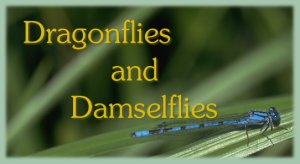

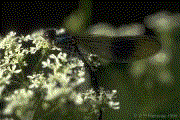
The Banded Demoiselle is the most striking damselfly to be found in Milton Keynes. It is easily and regularly observed on the River Ouse, the River Ouzel and in many of the linear parks. The male is coloured electric blue with large, dark blue patches on its wings. It can look like a black butterfly or day-flying moth over the water. The female is metallic green with transparent, greenish or pinkish wings. The similar species, Beautiful Demoiselle - Calopteryx virgo, is not found in Milton Keynes but can be seen on the upper reaches of the River Tove at Abthorpe, near Towcester, only 10 miles away.
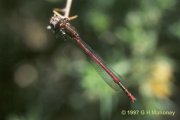
The Large Red Damselfly is the earliest species to be seen on the wing in most years. It is around in May, sometimes as early as April. It is the only red damselfly found in Milton Keynes. The male and female may be distinguished by the amount of black on the abdomen - the female is more widely marked with black. These damselflies are seen all over the Borough. Good sites are the Blue Lagoon and the Teardrop lakes.
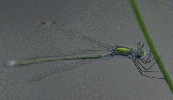
The Emerald Damselfly is not easily observed as it spends much of its time hiding in the vegetation near marshy areas. The male is metallic emerald green with powdery blue patches at each end of the abdomen. The female is also metallic emerald but without the blue patches. Immature females are sometimes pinkish or beige. This damselfly can be found at Howe Park Wood, Blue Lagoon and at Walton Lake in July and August.
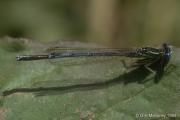
A bit of a speciality of the area, the White-Legged Damselfly is found along many of Milton Keynes rivers and streams. The male is pale blue with a black line running the length of the abdomen. The legs are flattened and white or very pale. They are waved in the courtship display. The mature female is pale green and marked like the male. Immature females are creamy-white in colour with few black markings - the only damselfly in Milton Keynes like this. They are on the wing in late June and July and congregate in great numbers on the Ouzel near Woughton.
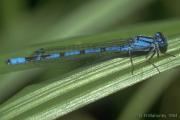
Male Common Blue Damselflies swarm over open water facing into the wind. It is very common in Milton Keynes and throughout the British Isles. The male is sky blue with black markings, the second segment of the abdomen has a mark like a rugby ball on a stalk. The female is Blue, Brown or olive-green with extensive black markings including a "Christmas tree" or double arrowhead on the eighth segment. These damselflies can be found over all ponds, lakes and canals in June, July and August.
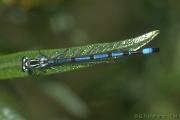
Easily confused with the preceding species, the male Azure Damselfly is most easily distinguished by the mark on the second segment - a black, square bottomed "U". If this is not obvious (and it will only usually be seen if you can get a very close look) then you may be able to use the fact that the head and thorax are less extensively coloured blue in this species. The female is blue or green with extensive black markings including a thistle head on the second segment of the abdomen. They have a similar habitat to the Common Blue but may also be seen in wet meadows. Their flight period is from May to September being most common in June and July.
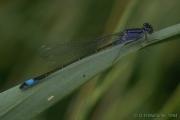
The Blue-Tailed Damselfly is very widely distributed and very common in Milton Keynes. It can be found among the vegetation at the edges of most water bodies but rarely ventures out over the water. It is the most tolerant of pollution of all damselflies and dragonflies and is sometimes the only species present over a body of water. The eyes of this species are never red but are usually black with blue spots. Both male and female are mainly black above with an obvious blue spot near the end of the abdomen. The thorax is blue and black striped in the male and usually green and black in the female. However there are many different colour forms of the female. The thorax can be striped green, blue, brown, violet or salmon pink and the spot on the tail can also vary. The adults have two flight periods late May and early June, then again in late June and July.
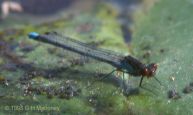
The Red-Eyed Damselfly is usually seen basking on floating vegetation, particularly water lily leaves, on lakes, slow rivers such as the Ouse and canals. Like the preceding species, it has a blue spot near the tip of the abdomen but is easily distinguished because of its deep red eyes and robust, blue and bronzy-black thorax. The male often develops a powdery grey appearance to the abdomen as it ages. Females are similar in shape and pattern but with green replacing the blue on the thorax and lacking the tail spot. Usually seen in June and July, good sites are Emberton Country Park, Blue Lagoon and the Teardrop lakes.
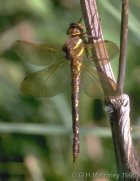
The Brown Hawker is unmistakable. It is the only dragonfly found in the area with golden brown, transparent wings. Like many of the hawkers, it can be found well away from water and on one summer evening meeting dozens of these creatures were seen basking on the trunks of trees in Little Linford Wood. Both male and female are large, strong flying, brown insects with some blue and yellow spots on the abdomen and with yellowish-green stripes on the side of the thorax. Most often seen from July to September.
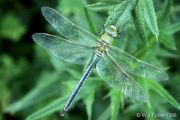
This is Milton Keynes largest dragonfly. The Emperor Dragonfly is seen hawking over open water on most of the lakes of Milton Keynes. It can fly for very long periods, never seeming to settle and covering a regular "beat". The male has a bright blue abdomen marked with black and a green thorax. The female is mainly green and black. In flight, the abdomen is often held in a curve with the tail end pointing slightly downwards. Good sites to see this magnificent insect are Emberton Country Park, the Teardrop lakes and Walton Lake. Its flight period is from June to early August.
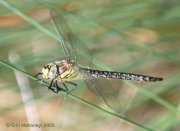
The Hairy Dragonfly is the only Hawker to be seen flying in May or early June. The flight season is over by the end of June. At first glance it looks like a small Aeshna cyanea. Distinguishing features are the downy appearance of the thorax and abdomen, the narrower, parallel ante-humeral stripes and that the blue dots near the tail end of the abdomen are never joined to form a band. It was first recorded from Milton Keynes in 1998 and has now been seen at Great Linford Lakes, Blue Lagoon and Mount Farm Lake. It often flies along a regular beat in and out of the reeds about a meter from the water surface. This species is generally extending its range throughout Britain.
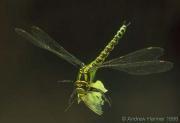
The striking large, black body with blue and green spots make the Southern Hawker easy to identify. The spots on the abdomen are yellowish-green near the thorax changing through pale green to pale blue near the tail end, these tail spots being joined to form a band. The female never has any of the pale blue marks and the spots are generally smaller. There are a number of similar species including the much smaller Hairy Dragonfly and Migrant Hawker. It is frequently found well away from water, I have seen it in the City Centre hawking around the main shopping building. It may fly late into the evening and is sometimes encountered flying along woodland rides at dusk. Flying from July to the end of September.
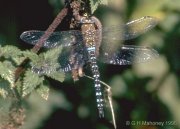
The Migrant Hawker is one of the few dragonflies that is increasing in numbers in Britain. At one time is was a rare migrant, hence its name, but is now more common than the Common Hawker! It is the smallest of the hawkers and often gathers in large swarms over fields at woodland edges or near lakes. The male is brown with blue spots all along the abdomen. The female is similar but the blue spots are smaller. Both male and female have a distinctive yellow, golf tee shaped mark on the second and third segments of the abdomen. These insects fly late into the year being seen from August to October or even November in good years. I have seen them in large numbers at Shenley Wood and at Emberton Park.
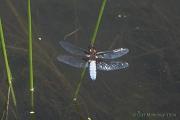
A distinctive insect, the Broad-Bodied Chaser is seen flying over ponds and lakes throughout Milton Keynes. The male's abdomen is powder blue with a row of yellow spots along the margins. The female is brown with yellow spots. Both sexes are very broad for their length appearing quite fat. Each has dark eyes and a dark patch at the base of each wing. These attractive creatures can be seen on the wing from May to August. Good sites are the ponds at Howe Park Wood and at the Teardrop lakes.
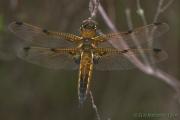
Closely related to the previous species, the Four-Spotted Chaser is easily distinguished by its wing markings. It is a slimmer insect than the preceding, both male and female are brown with yellow spots on the margins of the abdomen. Each wing has two dark spots, one near the tip (the pterostigma) and one half way along the leading edge (the nodus). Very common in Milton Keynes, this can be seen on most lakes and ponds from June to September. Good sites are Blue Lagoon, Emberton Country Park and Howe Park Wood.
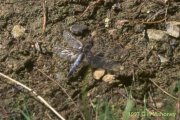
The Black-Tailed Skimmer is probably most easily identified by its habit of resting on bare patches of ground such as gravel paths or bare earth. The mature male is powdery blue with a black tail end to the abdomen. The thorax and eyes appear very dark brown or green. The immature male and the female are yellowish-brown with black markings along both sides of the abdomen. Common at Blue Lagoon, Great Linford and Howe Park Wood during June and July.
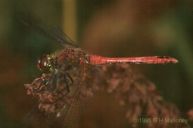
The male Ruddy Darter is a striking blood-red insect. The legs are black and the eyes dark red. The abdomen has a slight waist (hour-glass figure) around the fourth segment. The female is a less striking greeny-brown sometimes developing red lines along the segment boundaries with age. It is a small dragonfly and is usually seen hunting along rides or hedges near water. It is easily confused with the following species, the females in particular are very difficult to tell apart. This is a quite uncommon species but I have recorded it from several sites including Howe Park Wood, Great Linford and Emberton Park. Fight period is July to September.
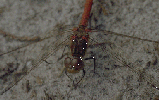
The Common Darter is similar to the Ruddy Darter and has very similar habitat requirements. The male is more of an orange red in colour and has light patches on the thorax which the Ruddy Darter lacks. Its legs are black with a pale yellow line along them though this is not obvious unless you can observe the insect very closely. The female is yellowish-brown sometimes developing red lines along the segment boundaries of the abdomen. This species is much more common than the Ruddy Darter and can be seen in large numbers on many ponds and lakes. It is the commonest dragonfly on the ponds at Howe Park Wood. The flight period is from mid June to late October.
The eighteen species described are the only ones formally recorded for Milton Keynes. Other species may turn up including the Scarce Chaser, found on the Ouse near Huntingdon, or the Variable Damselfly, very similar to the Azure and recorded from Stevington and Leighton Buzzard in Bedfordshire in the 1940s. Other migrants that could be observed in Milton Keynes if you are really lucky include the Red-Veined Darter and the Yellow-Winged Darter, both of these species are irregular migrants from the continent to Southern and Eastern England. In August 1995 unusually large numbers of Yellow-Winged Darter found their way over from the Continent. Several were seen in Milton Keynes.
The Beautiful Demoiselle is found on the River Tove, above Greens Norton. By the time the Tove gets into Milton Keynes it is no longer suitable for this species.
The following books were used to help me build up the key and the descriptions:
Askew, R. R.,The Dragonflies of Europe,1988.
Cham, Stephen, Bedfordshire Dragonflies - A Provisional Atlas of the Dragonflies of Bedfordshire, 1990.
Hammond, C. O., The Dragonflies of Great Britain and Ireland, 1983.
McGeeney, Andrew, British Dragonflies, 1986.







